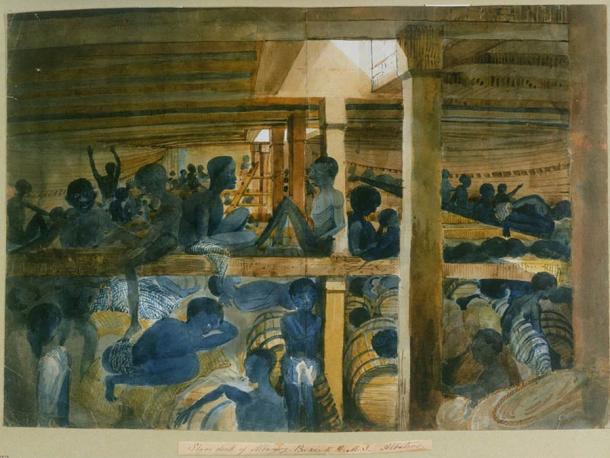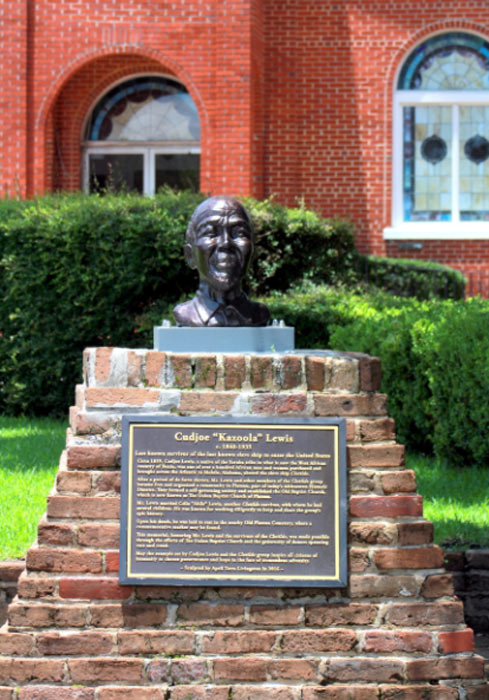
Clotilda, the Last Ship Used in U.S. Slave Trade Found Remarkably Intact
The remains of the last known active slave ship in the United States have been marooned in the mud at the bottom of the Mobile Delta for more than 160 years. Since the wreckage of the ship known as the Clotilda was first discovered in 2019, underwater archaeologists and historians have been closely studying the preserved wooden remnants of the two-masted schooner, which was burned and scuttled after delivering an illegal shipment of slaves to a slave trader in Mobile, Alabama in 1860.
Astonishingly, these examinations have revealed that the Clotilda is still largely intact, according to a report released by the Alabama Historical Commission to the Associated Press. Various sections of the 86-foot (26-meter) schooner have been identified, including the large hold or pen in the ship’s belly that functioned as a prison for the 110 African captives who were transported across the sea to the Americas on the ship’s grim 1860 voyage.
The decision by Captain William Foster to sink his rogue vessel after initially setting it ablaze appears to have prevented the fire from doing too much damage. The upper deck was destroyed by the fire, but everything below deck has been well preserved. The ship was also scuttled in a location that has not been subject to dredging operations, which could have buried it forever. Consequently, scholars will now have an opportunity to learn more about the characteristics of the Clotilda, which was originally built to carry lumber before being repurposed for a far more sinister task.
- “Hold Me Or I Will Run!” Roman Slave Collars Came With A Warning
- Wreck of Maya Slave Ship Found in Gulf of Mexico

Captives being brought on board a slave ship from the west coast of Africa. (CC BY-SA 4.0)
Finding the Clotilda, and Remembering an Historical Tragedy
Underwater explorers and adventurers had been searching for the remains of the Clotilda in the Mobile Delta for more than 100 years. It was known to be there, because Captain Foster testified to its whereabouts after he and the man who commissioned his last trip, wealthy shipyard owner (and slave trader) Timothy Meaher, were arrested and charged with violating the Congressional act that prohibited the trans-Atlantic slave trade in 1808. These men had used the vessel to secretly import 110 men from the West African Kingdom of Dahomey, which frequently sold captives from their various wars to illicit European and American slave traders.
The massive Mobile Delta, which was created by the confluence of the Alabama and Tombigbee Rivers just north of Mobile Bay on Alabama’s Gulf of Mexico coastline, covers more than 20,000 acres (8,100 hectares) of surface area. This created quite the challenge for explorers, whose only had a general idea of where the remains of the Clotilda might be located.

One of the search vessels at the Mobile River. (SEARCH Inc)
After several false claims of discovery (the Clotilda is only one of many sunken ships that litter the bottom of the Mobile Delta), the actual wreck was finally discovered in 2019 by explorer Ben Raines. Once the Alabama Historical Commission had confirmed the legitimacy of the finding, researchers were able to begin their intensive study of the underwater wreckage.
They didn’t expect to find much at first, given the immense passage of time and the knowledge that the ship had been burned before it was sunk. But surveys have revealed a lot about the architectural features and past contents of the Clotilda, which makes its discovery highly significant from an historical perspective.
Maritime archaeologist James Delgado, whose private exploration company SEARCH Inc. carried out the latest surveys, refers to the state of the Clotilda as “a stunning revelation.”
"It's the most intact [slave ship] wreck ever discovered," he noted. "It's because it's sitting in the Mobile-Tensaw Delta with fresh water and in mud that protected it that it's still there."
- Does Newfoundland Have the Oldest Intact Ancient Ships in the World?
- World’s Oldest Slave Cemetery May Have Been Found

Side-scan sonar image of archaeological site 1Ba704, the wreck of Clotilda. The dotted lines show the ship’s stern and full projected length. (Courtesy SEARCH Inc. / Archaeology Mag)
As the studies have revealed, the slave hold below the ship’s main deck would have been a dark and dank prison. It would have offered access to neither natural light nor ventilation to its occupants during their months-long journey across the Atlantic. The 1860 return trip to the United States took place during the summer months, which means the Africans packed in below the upper deck would have had to endure high levels of heat throughout the duration of their voyage.
It isn’t known how many of the 110 people who were included in the original purchase of slaves actually survived the brutal and legally prohibited journey. But there almost certainly would have been fatalities, given the extreme and inhuman conditions to which they were exposed.

Transatlantic Slave Ship by Lieutenant Francis Meynell (CC BY-SA 4.0)
The Amazing Story of Africatown
The slaves brought over on the Clotilda were unusual, in that they were among a relatively small number of first-generation Africans to be emancipated when slavery ended in the United States at the conclusion of the Civil War in 1865. Since they’d been in the Americas for such a short time, they hadn’t been away from their home region of West Africa long enough to lose contact with their native language and cultural traditions. These individuals were part of a group known as the Takpa people, who spoke Yoruba and occupied parts of modern-day Nigeria.
Seeking to preserve their traditions as long as possible, 32 ex-slaves who’d arrived in America on the Clotilda decided to form their own self-contained community shortly after emancipation. Led by Cudio Kazoola Lewis, who exhibited natural leadership skills essential to the undertaking of such an ambitious project, these 32 first-generation Africans purchased a few acres of land located about three miles (five kilometers) from the city of Mobile. It was here the ex-slaves incorporated Africatown, which would be inhabited by its 32 original founders plus other first-generation Africans who’d been illegally purchased in Africa and transported to the United States on other vessels.

Monument to Cudjoe Lewis, last survivor of America’s last slave ship, the Clotilda, Africatown, Mobile, Alabama. (CC BY-SA 4.0)
The purpose of this community-building project was to resist assimilation and cultural extinction. All former slaves who’d been born in Africa before being forcibly relocated to the American South were welcome, and hundreds ultimately flocked to an enclave where they would remain free to speak the West African Yoruba language while preserving other important traditions they’d brought with them from their homeland. The members of the community did quickly adopt Christianity as their official religion, but that was the only significant change the people of Africatown made in their cultural and social practices.
Despite the deeply repressive and often violent racism that the Africans living in the south faced in the 19th and 20th centuries, the Africatown project was a success. In the first half of the 20th century, the population of the burgeoning community surpassed the 12,000 level, as the community expanded to cover an area of approximately 57 acres (hectares). Paper mills brought jobs and economic opportunity to Africatown residents, who learned enough English to survive but for the most part continued to speak Yoruba and otherwise stayed true to their African roots.
Following World War II, Africatown lost its independent standing after being absorbed by the city of Mobile. Today it is recognized as a historic neighborhood by city officials, and remains home to approximately 2,000 mostly African-American residents (about 100 of whom are the descendants of Clotilda survivors).
While Africatown is no longer an enclave for exclusively African culture, the Clotilda Descendants Association is doing its best to make sure the story of the Clotilda survivors and all they accomplished is not forgotten.
Their primary focus is to preserve the unforgettable stories passed on by their forefathers, who experienced both tragedies and triumphs during their enslavement and in the decades beyond. Nevertheless, association leaders are excited about the discoveries made by the underwater archaeologists who’ve been exploring the Clotilda wreck.
“I think it’s going to be a surprise for us all,” commented Jocelyn Davis, the vice president of the association and a sixth-generation granddaughter of one of the Clotilda captives and Africatown founders.
Even Terrible History Should Be Remembered and Preserved
The Alabama Historical Commission has pledged to spend up to $1 million on continued research and preservation operations, which will include further explorations of the ship’s remains starting in early 2022. According to Delgado, as of now no one is sure if the ship can actually be removed from the water and put on public display.
“Generally, raising is a very expensive proposition,” he said. “My sense is that while it has survived, it is more fragile than people think. A recovery could be a very delicate operation and also a very expensive and lengthy process.”
While the ultimate fate of the Clotilda has yet to be decided, the site of the shipwreck was officially recognized by the U.S. National Register of Historic Places in November. This guarantees the site will be protected from dredging operations and other types of unlicensed intrusions, guaranteeing the ship will be preserved in one form or another from now on.
Top image: This sonar image created by SEARCH Inc. shows the remains of the Clotilda, the last known U.S. ship involved in the trans-Atlantic slave trade. Source: SEARCH Inc. / AHC
By Nathan Falde
















Comments
Hi All,
That's the last Slave Ship to North America, South America continued trafficking African Slaves as late 1880, in B Argentina/Brazil, Guatemala & 1890 into Peru. Those are the dates when South America up and abolished African Slavery.
Meanwhile back on the shores of North America Douglas A. Blackmon wrote his Book Slavery by Another Name.
At least the Trafficked African's from The Clotilda were able to keep their History, Culture and language. Somehow this reminds me of Gullah, Gullah in South Carolina.
This is all I've got to share about this discussion so until next time everyone, Goodbye and Have a Happy New Year.